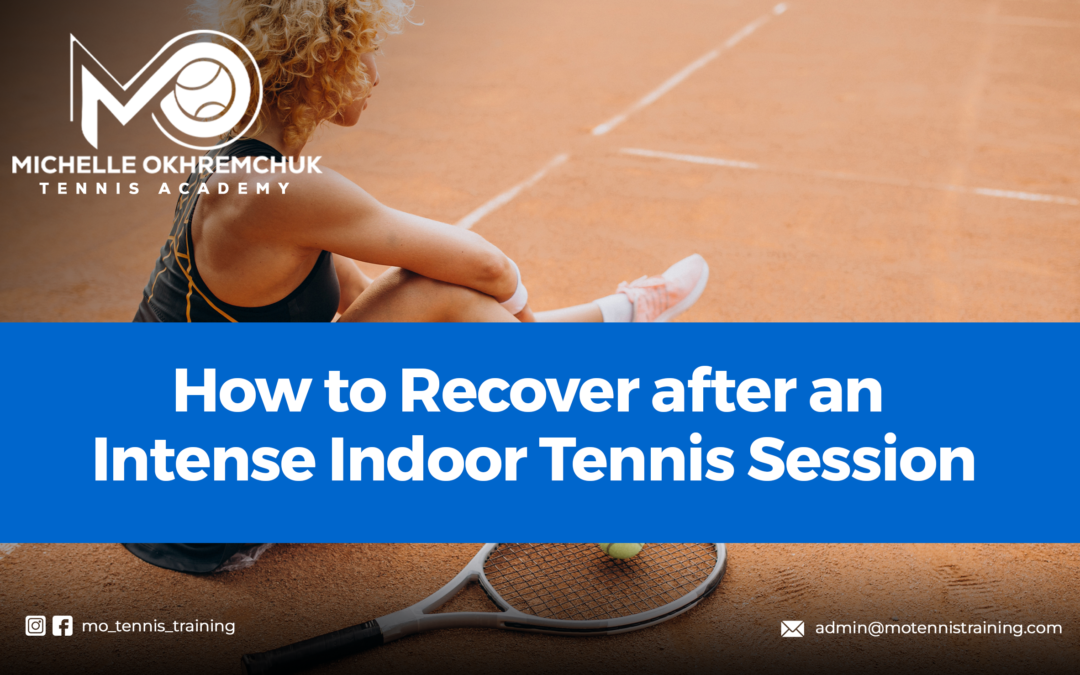Indoor tennis offers a fast-paced and exhilarating workout, pushing your agility, reflexes, and endurance. While the thrill of the game is undeniable, those intense rallies can leave your body feeling drained and sore.
This guide provides a comprehensive roadmap to post-tennis recovery, ensuring you feel refreshed and ready to dominate your next match.
We discuss the physical demands of indoor tennis, highlighting the importance of proper recovery. We’ll explore strategies to prepare for those high-energy sessions, cool-down exercises to minimize muscle fatigue, and essential hydration and nutrition tips to refuel your body.
We’ll also delve into the power of rest and active recovery, ensuring your muscles have ample time to repair and rebuild.
Let’s dive into how you can bounce back stronger after a challenging indoor tennis session!
The Physical Demands of Indoor Tennis
Indoor tennis is a dynamic sport that requires agility, speed, and quick reflexes to outmaneuver your opponent on the court. The fast-paced nature of indoor tennis means you’re constantly moving, changing direction, and hitting powerful shots.
The confined space of an indoor court adds an extra challenge as players need to adjust their footwork and positioning quickly. This constant movement significantly strains your muscles, especially in the legs and core areas. The explosive movements involved in serving or returning shots demand strong physical endurance. Players must be able to sprint towards the ball one moment and then execute a precise shot accurately, the next.
Indoor tennis matches can often last for extended periods, testing your physical stamina and mental focus throughout each set. Proper conditioning and preparation are crucial to effectively meet these demanding physical requirements of indoor tennis.
Importance of Proper Recovery
After an intense indoor tennis session, the importance of proper recovery cannot be overstated. Your body goes through a lot during those fast-paced matches and high-intensity rallies. Recovery is key to preventing injuries and ensuring peak performance in future games.
Allowing your muscles and joints to recover properly after exertion is crucial. It helps reduce muscle soreness, inflammation, and fatigue. Incorporating rest days into your training schedule is essential for giving your body the time it needs to repair and rebuild.
Proper recovery includes stretching, foam rolling, or even gentle yoga sessions. These practices can help improve flexibility, increase blood flow to tired muscles, and aid in flushing out toxins from your system.
Hydration plays a vital role in the recovery process as well. Drinking enough water before, during, and after your indoor tennis session helps replenish lost fluids and keeps you hydrated for optimal performance.
Remember that listening to your body’s signals is crucial for recovery. If you’re feeling excessively fatigued or experiencing persistent pain, don’t hesitate to give yourself extra time to rest and recuperate before hitting the court again.
Preparing for an Intense Indoor Tennis Session
As a tennis player gearing up for an intense indoor session, preparation is key to performing at your best. Start by ensuring you have the right equipment – a well-strung racket, comfortable shoes, and appropriate attire that allows for movement.
Next, mentally prepare yourself by visualizing successful plays and focusing on your game plan. It’s essential to arrive early to warm up properly and acclimate to court conditions. Stretching is crucial to prevent injuries and improve flexibility during gameplay.
Don’t forget to stay hydrated leading up to your match and fuel your body with nutritious snacks like fruits or energy bars. Maintain a positive mindset, and remember that each session is an opportunity for growth and improvement in your game.
Cool Down Exercises
After an intense indoor tennis session, it’s crucial to cool down your body properly. Cool down exercises help prevent injury and reduce muscle soreness. Start by slowing down your movements and incorporating gentle stretches for all major muscle groups. Focus on areas like your arms, legs, back, and shoulders.
Consider using a foam roller to release any tension in your muscles. Foam rolling can help improve flexibility and circulation while reducing post-exercise stiffness. Don’t forget about the importance of deep breathing during your cool-down. Take slow, deep breaths to signal to your body that it’s time to relax and recover.
Finish off with light walking or jogging to gradually bring your heart rate back down. Allow yourself at least 5-10 minutes for a proper cooldown routine after playing indoor tennis.
Hydration and Nutrition Tips
Staying properly hydrated and nourished is crucial for maximizing your performance in indoor tennis. During intense sessions, you lose a lot of fluids through sweat, so it’s essential to drink plenty of water before, during, and after your training.
Opt for snacks rich in carbohydrates and protein to fuel your body adequately. Bananas, nuts, or energy bars can be great options to keep you energized throughout the session. Avoid heavy meals right before playing as they can make you feel sluggish on the court. Instead, aim for light but nutrient-dense meals a few hours prior to your game.
Electrolyte drinks can also help replenish lost minerals during intense matches. However, be mindful of the sugar content in some sports drinks – opt for low-sugar or natural alternatives if possible.
Rest and Active Recovery
Rest and active recovery are crucial components in helping your body recuperate after an intense indoor tennis session. When you push yourself on the court, it’s essential to give your muscles time to repair and rebuild. Rest allows for this process to happen naturally, aiding in muscle growth and overall performance improvement.
Incorporating active recovery techniques like light stretching or yoga can help increase blood flow to fatigued muscles, reducing soreness and promoting flexibility. Activities such as swimming or cycling at a low intensity can also assist in flushing out lactic acid buildup from strenuous exercise sessions.
Proper rest and active recovery play a significant role in injury prevention by giving your body the chance to recover fully before engaging in another intense workout.
Conclusion
Recovering after an intense indoor tennis session is crucial for your overall performance and well-being.
By understanding the physical demands of indoor tennis, prioritizing proper recovery techniques, and taking care of your body through hydration, nutrition, rest, and active recovery, you can optimize your post-training experience.
Take these recovery tips seriously to ensure you’re always at the top of your game!


